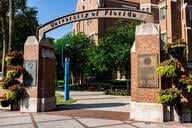You have /5 articles left.
Sign up for a free account or log in.
In the past, I’ve been critical of bundles.
In my 2015 book, College Disrupted: The Great Unbundling of Higher Education, I describe degree programs -- the economic engine of higher education -- as bundles of remedial course work, general education courses and advanced courses in the major. What’s more, this bundle of instruction is itself bundled with a range of tangentially related services, as Anant Agarwal, president of edX, has enumerated: “Admissions, research, facilities management, housing, health care, credentialing, food service, athletic facilities, career guidance and placement, and much more.”
There’s a good reason to bundle college. Many products and services are easier to use when they’re bundled, and often easier to market and understand. The impact can be profound. The bundle known as the iPhone has transformed lives in a way that no disconnected set of hardware, software and services ever could. Similarly, over the past 50 years, the college bundle -- no less audacious and seductive than Steve Jobs’s vision for the iPhone -- has dominated public attention and wallets to become the only pathway from youth to a remunerative and respected adulthood, at the expense of other forms of human capital development.
The bundle has been highly rewarding for higher education. Colleges and universities are now a $500 billion industry employing over four million faculty, staff and administrators. The bundle has helped to build and support families and entire communities. About half of this spending is sourced from willing governments, reflecting the public’s college consensus. Employers contribute $20 billion. The rest comes from students and their families.
At the same time, the bundle is at the root of higher education’s dual crises of affordability and employability. As Apple’s $237 billion pile of cash amply demonstrates, bundling captures surplus for producers. And surplus capture has permitted tuition hikes at double the rate of inflation (and recently room, board and student fee hikes at double the rate of tuition), resulting in $1.56 trillion of student loan debt. Likewise, smug that the bundle’s allure would keep paying and borrowing students walking through the gate, colleges and universities haven’t exactly upended legacy practices to prioritize student outcomes, like whether students complete, or graduates get good first jobs.
What does the unbundling of higher education look like? In his book The End of College, Kevin Carey introduces the University of Everywhere, consisting primarily of online courses and resources, reducing costs and increasing access. In my view, as online is an imperfect modality for developing soft skills and digital skills, it’s unlikely to constitute the main bridge from K-12 to employment. Instead, unbundling comes from millions of students opting for faster and cheaper on-ground, immersive, workplace-like pathways to good first jobs.
Whatever your vision of unbundling college, I’m not a lunatic about it. I agree with critics like the vice chancellor of the U.K.’s University of Portsmouth, who recently pointed out to me that students shouldn’t be able to opt out of mental health services, or elements that build necessary social capital. To do so would be to disadvantage students in greatest need of our help. “University is a complex good. It necessarily involves some redistribution of resources from some students to others. Unbundling and letting students choose which bits of the university experience they want would shortchange them.” Nevertheless, I continue to believe that 50 years of pre-eminence has led to far too much complacence, and that unbundling represents the proper direction of travel for colleges and universities.
***
College’s position and vector stands in stark contrast to its twin quasar: work-force development.
What is work-force development? It’s a fragmented system of state and local work-force development or investment boards. These organizations are responsible for spending federal and state work-force dollars on “one-stop” career centers to help job seekers find jobs. Charged with human capital development, WIBs maintain long laundry lists of training programs operated by nonprofit organizations and community colleges and also provide access to an alphabet soup of public programs, e.g., HUD employment and training programs, Job Corps, Local Veterans’ Employment Representatives and Disabled Veterans’ Outreach Program, National Farmworker Jobs Program, and Senior Community Service Employment Program.
If college is the paradigm of bundled human capital development, today’s system of work-force development is its antithesis: a completely unbundled system. The very name itself -- one-stop center -- tries to prove too much, demonstrating insecurity around the many organizations providing services to the typical client. The one-stop center attempts to coordinate. But because everything is outsourced, getting lost in the shuffle is a common experience.
So while most Americans can rattle off the names of small and obscure colleges, few understand or have even heard of work-force boards: the lack of a clear bundle makes them much harder to grasp. The same is true of public support for work-force development, which falls short of college by an order of magnitude. The federal government spends only $19 billion of education and defense funding on career education and training. Department of Labor funds don’t add much. Federal spending on work-force development through the Workforce Innovation and Opportunity Act (WIOA) is only about $1 billion (the remainder of the $3.3 billion in WIOA spending is allocated to disability and youth programs).
Work-force development’s lack of resources has led to a system that prioritizes keeping cost per client low, that emphasizes counseling over education and training, and where performance is measured on speed to placement, not on value added. So it should be no wonder that work-force boards find themselves in a vicious circle of attracting only low-skill workers, and only the lowest-skill positions from employers; there’s little opportunity or rationale for value add.
***
If we’re ever going to have work-force programs that rival college as pathways to employment in terms of support, prominence and/or effectiveness, work-force development must take a page from higher education’s textbook and begin to bundle. I don’t mean research budgets and lazy rivers. I mean full-stack solutions that directly overcome the key barriers keeping both job seekers and employers from bridging the education-to-employment gap.
What are these barriers? For individuals, it’s education friction. Education friction explains why most Americans don’t go out and equip themselves with the skills employers are seeking. It’s the time to upskill, the cost of upskilling and -- most important -- the uncertainty of a positive employment outcome. Eliminating education friction should be the Holy Grail of any work-force bundle. But that’s not nearly enough. There’s also hiring friction on the employer side. Hiring friction explains nearly seven million unfilled jobs: due to the increasing cost of bad hires and high churn in entry-level jobs, American employers are increasingly reluctant to hire candidates who haven’t already proven they can do the job. It explains why many employers now require years of relevant experience for positions that should be (and once were) entry level.
Over the past five years, a number of terrific not-for-profit organizations backed by well-meaning foundations, families and corporations have begun trying to reinvent work-force development with new pathways to employment. But because they haven’t committed to abandoning the fragmented work-force paradigm, none of them have addressed hiring friction by serving as the employer of record for “graduates” and allowing employers to try unproven talent before they’re asked to buy. Hiring friction is best addressed via bundled work-force solutions -- i.e., not a one-stop source of referrals, but rather a single provider with a mission of scaling the provision of entry-level talent through a more bundled value proposition for both individuals and employers.
The story of American work-force development -- particularly when thrown into relief by the college colossus -- is that an unbundled system has its limits, particularly when faced with a population ill equipped to navigate it (the same concerns around unbundling in higher education) and employers that insist on the perfect candidate served up on a silver platter (or they won’t hire). I’m convinced work-force development’s next decade will look very different. The inspiration is easy to find: our beloved, bundled alma mater. Emerging bundled work-force pathways that eliminate both education friction and hiring friction are poised to close the skills gap across a wide range of sectors and job functions. And by eliminating hiring friction, many more employers will be drawn to work-force pathways: replacing work-force development’s current low-skill vicious circle with a virtuous circle.
So while college unbundles, watch for work-force development to bundle. They’ll meet somewhere in the middle both in terms of models and popularity. And as they do, America will find itself with a system of human capital development that is much more balanced and sensible.




